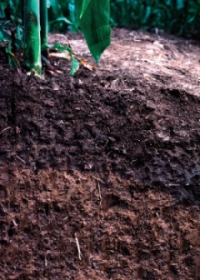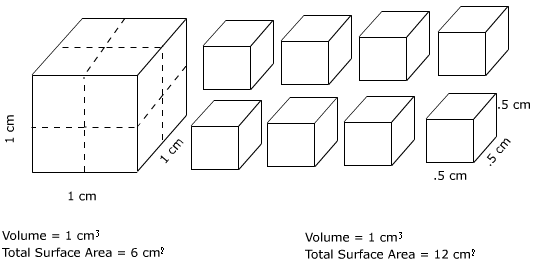Soil DevelopmentSoil forms from a complex interaction between earth
materials, climate, and organisms acting over time. The brightly colored
soils of the humid tropics reflect the intense chemical
reactions occurring in warm climates. The fertile prairie soils
of the American Midwest evolved from the nutrient-rich organic
matter left by decaying grasses. Regardless of soil
characteristics, the whole process starts with the breakdown of earth material. Figure 11. 1 Soil profile in central Iowa WeatheringWeathering refers to processes that physically breakdown and chemically alter earth material. Physical weathering, also known as mechanical weathering, is the breakdown of large pieces of earth material into smaller ones. Think of physical weathering as the disintegration of rock without changing its chemical composition. There are many ways earth material can be physically weathered. When water freezes in rock crevices it expands creating stress in the crevice. As the stress increases, the crevice widens ultimately breaking the rock. Plant roots wedge rocks apart as they grow into rock crevices too. The shrinking and swelling by alternating heating and cooling weakens mineral bonds causing the rock to disintegrate. A very important result of physical weathering
is its impact on the surface area of weathered material. When a
block of earth material is broken into several smaller pieces,
the amount of exposed surface increases. Examine the diagram
below. A block with a width, depth, and height of 1 cm has
a total surface area of 6 square centimeters. If we break the
block in half in all directions it yields eight smaller pieces
all with width, height, and depth of .5 cm. Breaking the block
apart creates additional exposed surfaces such that the total
surface area is now 12 square centimeters. Having more total
exposed surface provides more area upon which chemical reactions
can take place to further weather the material. The shape
of the pieces also affects the the amount of exposed surface
area. Plate-like pieces have more exposed surface area than do
block-like pieces. [
Figure 11.2 Effect of physical weathering on surface area Chemical weathering breaks down earth material by chemical alteration. This usually means adding a substance like water or air to the material. For instance, when oxygen is added to iron bearing minerals, oxidation takes places and a loose mantle of iron oxide is created (rust). Hydrolysis is an exchange reaction involving minerals and water. Free hydrogen (H+) and hydroxide (OH)- ions in water replace mineral ions and drive them into solution. As a result, the mineral's structure is changed into a new form. Hydrolysis is a common process whereby silicate minerals are weathered into a clay mineral. Think of chemical weathering as the decomposition of earth material. The spatial variation of climate and organisms play a significant role in the weathering of earth materials. Dry locations tend to be dominated by physical weathering and moist places by chemical weathering. The type of earth material available also determines the amount of weathering that might take place. Limestone is easily broken down where abundant rainfall and high temperatures prevail. However, limestone will remain intact in dry locations. The end result of the weathering process is the creation of a weathered mantle. The weathered mantle is not yet a soil until it undergoes further change. This involves the addition, transformation, translocation and removal of materials from the weathered mantle to form distinctive soil layers. |


